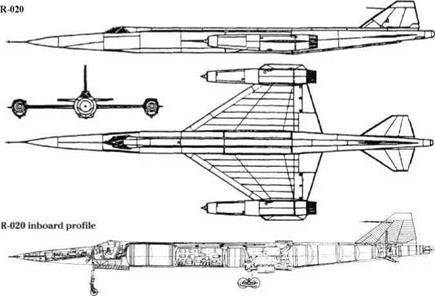Tsybin RSR, R-020
 |
Purpose: To improve the RSR further.
Design Bureau: OKB-256, Podberez’ye, later repeatedly transferred (see below).
Upon receipt of data from the NM-1, the RSR had to be largely redesigned. Construction was only marginally held up, and in early 1959 drawings for the first five pre-series R-020 aircraft were issued to Factory No 99 at Ulan-Ude. However, Tsybin’s impressive aircraft had their commercial rivals and political enemies, some ofwhom just thought them too ‘far out’, and in any case vast sums were being transferred to missiles and space. On 1st October 1959 President Khrushchyev closed OKB-256, and the Ministry transferred the RSR programme to OKB-23 (General Constructor VM Mya – sishchev) at the vast Khrunichev works. The Poberez’ye facilities were taken over by A Ya Bereznyak (see BI story). The Khrunichev management carried out a feasibility study for construction of the R-020, but in October 1960 Myasishchev was appointed Director of CAHI (TsAGI). OKB-23 was closed, and the entire Khrunichev facility was assigned to giant space launchers. The RSR programme was thereupon again moved, this time to OKB-52. At first this organization’s General Constructor V N Chelomey supported Tsybin’s work, but increasingly it interfered with OKB-52’s main programmes. In April 1961, despite the difficulties, the five R-020 pre-series aircraft were essentially complete, waiting only for engines. In that month came an order to terminate the programme and scrap the five aircraft. The workforce bravely refused, pointing out how much had been accomplished and how near the aircraft were to being flown. The management quietly put them into storage (according to
V Pazhitnyi, the Tsybin team were told this was ‘for eventual further use’). Four years later, when the team had dispersed, the aircraft were removed to a scrapyard, though some parts were taken to the exhibition hall at the MoscowAviation Institute.
The airframe of the 1960 RSR differed in several ways from the 1957 version. To avoid surface-to-air missiles it was restressed to enable the aircraft to make a barrel roll to 42km (137,800ft). The wings were redesigned with eight instead of five major forged and machined ribs between the root and the engine. The leading edge was fitted with flaps, with maximum droop of 10°. The trailing edge was tapered more sharply, and area was maintained by adding a short section (virtually a strake) outboard of the engine. These extensions had a sharp-edged trapezoidal profile. According to Tsybin These extensions, added on the recommendation of CAHI, did not produce the desired effect and were omitted’, but they are shown in drawings. In fact, CAHI really wanted a total rethink of the wing, as related in the final Tsybin entry. The tailplane was redesigned with only 65 per cent as much area, with sharp taper and a span of only 3.8m (12ft 5%in). Its power unit was relocated ahead of the pivot, requiring No 6 (trim) tank to be moved forward and shortened. The fin was likewise greatly reduced in height and given sharper taper, and pivoted two frames further aft. The ventral strake underfin was replaced by an external ventral trimming fuel pipe. The main landing gear was redesigned as a four – wheel bogie with 750 x 250mm tyres, and the outrigger gears were replaced by hydraulically extended skids in case a nacelle should touch the ground. The pilot was given a better view,
with a deeper canopy and a sharp V (instead of flat) windscreen. The camera bay was redesigned with a flat bottom with sliding doors. The nose was given an angle-of-attack sensor, and a pitot probe was added ahead of the fin. The drop tanks were increased in diameter to 700mm (2ft 31/2in) but reduced in length to 5.8m (19ft) instead of 11.4m (37ft 4Min). Not least, the D-21 engines never became available, and had to be replaced by plain afterburning turbojets. The choice fell on the mass-produced Tuman – skii R-l IF, each rated at 3,940kg (8,686Ib) dry and 5,750kg (12,676 Ib) with afterburner. These were installed in longer and slimmer nacelles, with inlet sliding centrebodies pointing straight ahead instead of angled downwards.
There is no reason to doubt that the pre-series RSR, designated R-020, would have performed as advertised. It suffered from a Kremlin captivated by ICBMs and space, which took so much money that important aircraft programmes were abandoned. The United Kingdom similarly abandoned the Avro 730, a reconnaissance bomber using identical technology, but in this case it was for the insane reason that missiles would somehow actually replace aircraft. Only the USA had the vision and resources to create an aircraft in this class, and by setting their sights even higher the Lockheed SR-71 proved valuable for 45 years.
|
Dimensions |
||
|
Span (with small tip extensions) 10.66 m |
34 к 1 13/ in |
|
|
Length (excl nose probe) |
28.0 m |
91 ft 10% in |
|
Wing area |
64 m2 |
689 ft2 |
|
Weights |
||
|
Empty |
9,100kg |
20,062 Ib |
|
Fuel |
10,700kg |
23,589 Ib |
|
Loaded |
19,870kg |
43,805 Ib |
|
Performance |
||
|
Cruising speed at reduced |
||
|
altitude of 12 km (39,370 ft) 2,600 km/h |
1,616 mph (Mach 2.44) |
|
|
Service ceiling |
22,500 m |
73,819ft |
|
Range |
4,000 km |
2,486 miles take-off |
|
Take-off run |
1,200m |
3,937ft |
|
Landing speed/run |
2 1 0 km/h |
130.5 mph |
|
(with braking parachute) |
800 m |
2,625 ft |
|
R-020 centre fuselage at MAI.
|











